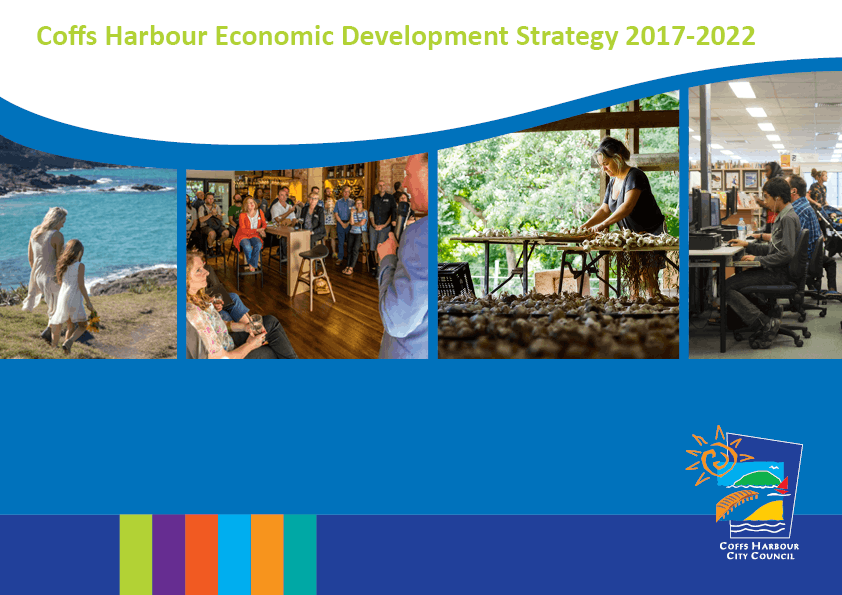FAQ
Why does Coffs Harbour need an economic development strategy?
The Coffs Harbour economy faces a number of development challenges and opportunities. The purpose of the Economic Development Strategy is to prioritise and focus Council resources to address these.
The Coffs Harbour LGA’s exports are dominated by construction (increased money flowing in from other areas due to the highway construction), agriculture, forestry, fishing, and tourism. Growth in agriculture has been driven by the blueberry sector which accounts for over 70% of local agricultural production, and equates to 92% of NSW blueberry production. The growth of this sector, counter-balanced with addressing sustainable land management practices, is very important. Bananas, in contrast, have experienced a relative decline.
The tourism sector is strong, stable, and showing signs of growth in recent years. There is untapped potential especially in the nature-based tourism sector (tours, experiences, soft adventure). There is a legacy of under-investment in tourism, especially with regard to accommodation.
Projected jobs growth is expected to be dominated by sectors focused on population growth (eg. household and personal services, health and age care, residential construction, retail) and tourism (accommodation, food services, retail). As the LGA continues its transition from a regional town to a regional city, the challenge is to develop the necessary investment in skills development to drive workforce employability which supports growth. Businesses and skills for the digital economy, in particular, are an important area of future development.
To achieve this transition, the following strategic objectives have been identified:
• The LGA needs to grow it’s capacity to become a more diverse economy. It is currently overly reliant on a relatively narrow, seasonal and cyclical base (agri-food, tourism, construction) which, in the absence of any remedial strategic action, increases the potential risk exposure of it’s growth plans.
• The LGA needs younger people to provide vitality, fill jobs and provide services, and increase economies of scale. As the population ages, workforce participation declines and the rate of economic growth naturally slows, while an ageing population creates demand for additional services and infrastructure.
• The LGA needs to attract business investment and skilled workers, energy and ideas (eg active Sea and Tree Changers). In order to ensure the Coffs Harbour LGA is not left behind, compared to other regional cities, Council and the community need to proactively identify and exploit sustainable yet untapped opportunities.
One of the principal aims of this strategy is to achieve a degree of sufficient consensus on the key economic development priorities facing the LGA, in order to guide decision making by Council, State and Federal agencies, business and the wider community.
How does this strategy relate to other strategies and plans of council?
The MyCoffs - Community Strategic Plan was prepared by Council on behalf of its community. The plan sets out goals and priorities for the LGA over the next ten years and beyond. It contains, amongst others, five broad economic goals to realise the community vision of a Connected, Sustainable and Thriving Coffs:
- Champion business, innovation and technology to stimulate economic growth and local jobs (B1.1 p14)
- Attract people to work, live and visit (B1.2)
- Prepare to exploit opportunities now and in the future (B2.1)
- Create and manage vibrant public places (C1.1)
- Effectively manage the planning and provision of regional public services and infrastructure (D2.1)
The refresh of the Coffs Harbour Economic Strategy 2014-2017 has dovetailed with the extensive community consultation and development of the My Coffs - Community Strategic Plan. A review was conducted in terms of the relevance of assumptions especially about demographic and economic projections. This showed the high level principles remained broadly applicable from the 2014-2017 strategy but the Action Plans were too numerous (175 of which less than 50% were delivered) to be addressed with Council’s resources and beyond the immediate ability of Council to deliver / influence.
Other council strategies were considered:
- The Coffs Harbour Events Strategy 2020 provides the strategic framework to attract, grow and retain events in the Coffs Harbour LGA. Events play an important role in reflecting the attractiveness of the
region and providing significant economic value back to the community.
- The Coffs Coast Tourism Strategic Plan 2020 adopted by Council in 2016 aims to strengthen the Coffs Coast visitor economy by increasing overnight visitor stays, length of stay, expenditure, and dispersal across the region. Given the significance of tourism to the Coffs Coast economy it is important that tourism is not only maintained and strengthened as an economic driver, but also planned and managed in a sustainable way.
- The Creative Coffs - Cultural Strategic Plan 2017-2022 highlights the opportunity that the region’s creative industries offer, harnessing arts and culture as a significant contributor to the city’s social and economic fabric through the creative sector’s contributions to employment, consumer spending, festivals and events and cultural tourism.
- Switched On Coffs Digital Strategy 2012, Local Growth Management Strategies, including the Public Realm Strategy (future), Residential Strategy (under development), Industrial Lands 2009, Rural Land Use strategy (LGMS), Coffs City Centre Masterplan, Woolgoolga Masterplan (WOW), Youth strategy (future) and other Council strategies were also considered.
Externally, the Federal Government’s Smart Cities Plan and the NSW Government’s North Coast Regional Plan 2036 were reviewed to understand the federal and state regional planning context for the Coffs Harbour LGA and align our strategies.
Council reviewed the latest available census and economic data. Consultation was undertaken with businesses, residents and key stakeholder groups through workshops, one on one meetings, committee meetings, briefings, focus groups, public forums and online surveys.
What are the key directions of the Draft Economic Development Strategy 2017 - 2022?
(1) Manage the planning and provision of regional public infrastructure
(2) Create and manage Vibrant Places
(3) Champion business, innovation and technology to stimulate economic growth and local jobs
(4) Attract people to invest, work, live, study and visit
(5) Prepare the future workforce
